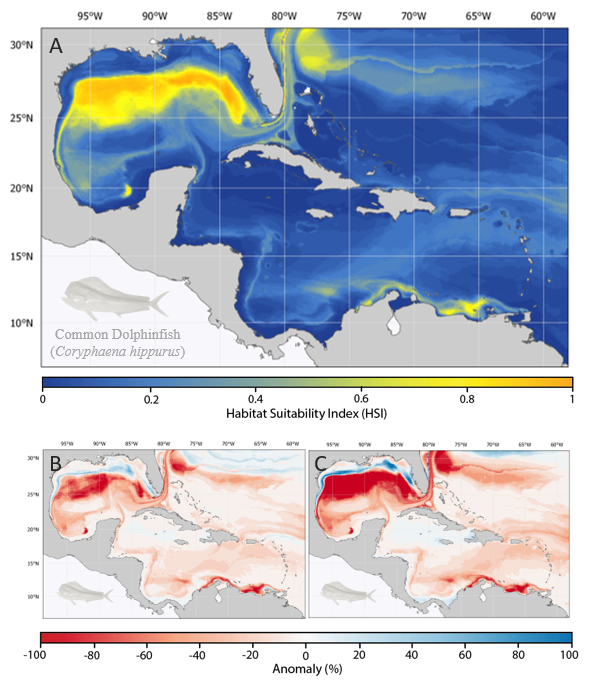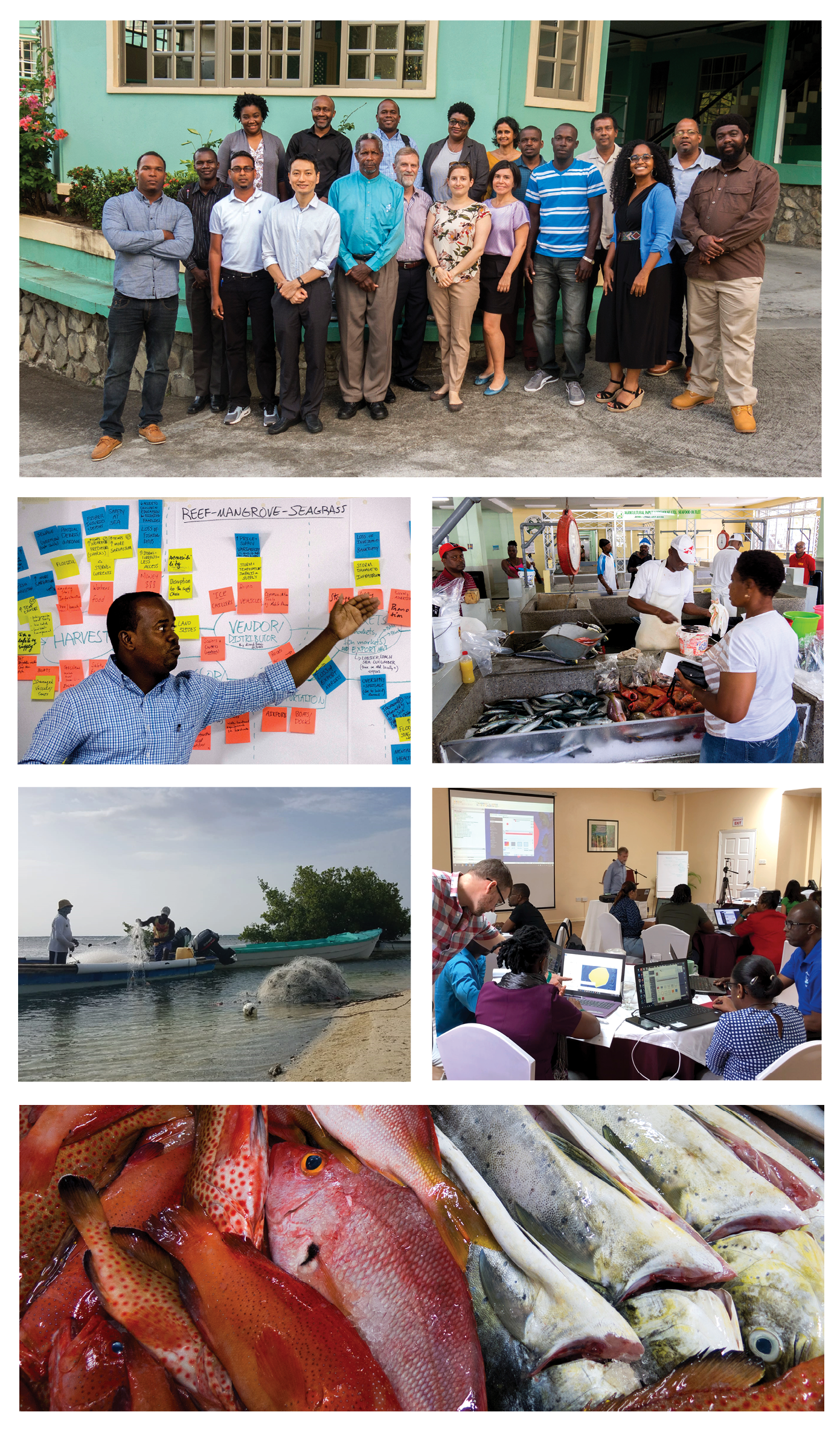Climate-Smart Fisheries Monitoring and Management Framework for the Caribbean
Project Details
Location: |
Caribbean Region (Multiple Countries); 17.994909, -75.153407 | |
Client: |
Caribbean Regional Fisheries Mechanism (CRFM), University of the West Indies (UWI) | |
Duration: |
2018 – 2020 | |
Team Member(s): |
Jimena Eyzaguirre, Natascia Tamburello, Darcy Pickard, Hugh Stimson, Tim Webb and external associates (Ahmed Khan, Ava-Gail Gardiner, Colette Wabnitz, Donovan Campbell, Gabrielle Raygondeau, Mike Jones, Richard Boyd and William Cheung) | |
Service Area(s): |
Fisheries & Aquatic Sciences, Climate Change Adaptation | |
Services Employed: |
Knowledge Synthesis, Ecological and Economic Modelling, Monitoring Framework Design, Policy Analysis, Science Communication, Training and Facilitation |
The Problem We Aimed to Solve
Marine biodiversity, ecosystems, and fisheries provide sustenance and livelihoods critical to human well-being in island and coastal communities around the world, including those in the Caribbean region. Although there is a growing recognition that climate change will have significant impacts on the fisheries sector, a lack of concrete information on potential impacts and practical guidance to improve climate resilience has constrained adaptation in the fisheries sector to date. This project aimed to improve availability and use of information for “climate-smart” planning and management in the fisheries and aquaculture sector in the Caribbean. This work was sponsored by the Inter-American Development Bank (IDB), as part of its investments in the Caribbean Regional Track of the Pilot Programme for Climate Resilience (PPCR), and executed in partnership with the Mona Office for Research and Innovation (MORI) at the University of West Indies at Mona, Jamaica, and with the Caribbean Regional Fisheries Mechanism (CRFM).
How We Helped
This project aimed to build a comprehensive foundation of information for guiding “climate-smart” adaptation planning and management in the Caribbean fisheries sector. Our work focused on six pilot countries including Jamaica, Haiti, Dominica, St. Lucia, St. Vincent and the Grenadines, and Grenada, but yielded data and insights applicable to the entire region.
The focal point of this project was to carry out detailed assessments of both the ecological and economic impacts of climate change on the Caribbean fisheries sector. The outputs of this work provide the first quantitative and spatially-explicit estimates of projected impacts to the distribution and abundance of over 100 key fisheries species, and use these estimates to calculate the cascading economic consequences of changes in species availability on the people, communities, and economies that depend on them. To support the translation of this information into action, we also developed a monitoring and management framework to help systematically track and respond to realized impacts and led an update of the 2013 Climate Change and Disaster Risk Management Regional Strategy and Action Plan for the sector to incorporate best practices that will guide regional climate change adaptation and disaster risk management in fisheries and aquaculture over the next ten years.
To help improve awareness of and engagement with these information products, this project also included a substantial outreach and education component including development of public awareness posters and a short documentary film aimed at the public; an educational slide deck on project outputs aimed at managers and decision-makers; and a 5-day hands-on training workshop for regional fisheries managers on using project data outputs, tools (models, R, QGIS), and communications products to support national adaptation programs for the fisheries sector.
Lastly, this project also included development of a CRFM data portal to provide an accessible and searchable platform for exploring and downloading the outputs of this project, as well as future projects affiliated with the CRFM.

Species-specific projected total habitat suitability index (HSI) and HSI’s change or ‘anomaly’ under different carbon dioxide emission levels for common dolphinfish (Coryphaena hippurus), one of 110 fisheries species examined in this study. (A) Total HSI for the contemporaty 1970 to 2000 period; (B and C) changes in HSI under scenarios of ~400 ppm and ~535 ppm atmospheric carbon dioxide concentration in the high resolution Earth system model (GFDL CM2.6).
Our Project’s Impacts
This project has helped to bridge a critical knowledge gap standing in the way of progress towards climate change adaptation in the fisheries sector. By adopting the monitoring and adaptation guidance provided through our work, regional fisheries managers will be able to better tailor adaptation strategies to the nature and magnitude of impacts observed at local scales rather than relying on generic modeling to guide decision-making. Although tailored to the Caribbean region, the guidance developed in this project can be adapted to a wide range of marine fisheries, and we hope that this work will contribute to broader mainstreaming of evidence-based adaptation planning for fisheries in a rapidly changing climate to ensure there is fish for today, and tomorrow.
“I am astounded at the quantity and quality of the outputs. In so far as quantifying the ecological and socio-economic impacts of climate change on fisheries at a scale that is useful for countries to make climate-resilient decisions – it is indeed the first time we have done this. We now have the basic tools and a standardized monitoring framework that will allow us to refine, repeat or upscale the analyses over time, and by this means, also to assess whether we are achieving the desired outcomes and how to adapt our strategies accordingly.”
– Dr. Elizabeth Mohammed, Senior Fisheries Officer, Trinidad and Tobago

Clockwise from top: ESSA Team (Jimena Eyzaguirre, Natascia Tamburello, Hugh Stimson and Tim Webb), collaborators (William Cheung and Ava-Gail Gardner), and regional fisheries representatives at the 2018 project kickoff workshop in Kingstown, St. Vincent and the Grenadines; a woman buying fish at the Kingstown Fish Market; ESSA team members (Hugh Stimson and Tim Webb) leading GIS training at the 2019 regional training workshop in St. Lucia; some important Caribbean fisheries species including dolphinfish, silk snapper, coney, and graysby; fishermen beach seining in Montego Bay, Jamaica, after participating in a Knowledge, Attitudes and Practices (KAP) Survey; a fisheries manager from Haiti talking through a group exercise to map climate change impacts on the fisheries value chain.
- CRFM website
- CRFM Data portal
- CRFM News Posts on ESSA project: http://www.crfm.int/index.php?option=com_k2&view=item&id=650:crfm-portal-making-fisheries-planning-smarter&Itemid=179 and http://www.crfm.int/index.php?option=com_k2&view=item&id=650:crfm-portal-making-fisheries-planning-smarter&Itemid=179
- Work Package 1 – Fisheries Climate Change Impact Assessment Report
- Posters
- Fish for Today and Tomorrow Video

